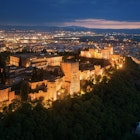
We make our way through a forest on the Galician coast at dawn. “Dad’s here,” I say to my partner Liz, as we stumble over a cobblestone path through a pine grove, the town of Poio and the monastery where we spent the night fading into a memory far below. In the two years since he passed away, it’s become common for my father to make his presence felt at particularly poignant moments near the end of a long journey.
Dad is with us again on the Variante Espiritual.
For nearly 1,300 years, Christian pilgrims have made voyages along the Camino de Santiago, following various routes winding through Europe, leading to the medieval Spanish citadel of Santiago de Compostela, where the remains of Saint James the apostle are said to be interred. And while the route beginning in France garners some 80% of pilgrim traffic these days, the trail Liz and I found ourselves on—the Camino Portugués—boasts about 20%.
That’s still enough traffic to fill the plentiful number of hostels and albergues dotting the nearly 300km path from Porto to Santiago during peak season. But on the Variante Espiritual, that crowd is trimmed to almost none. It’s the kind of place to find yourself alone with your thoughts, your partner or whatever ghosts haunt your steps around the planet.

Near the end of the average two-week voyage from Porto, pilgrims face a choice—add several days to the journey by detouring 28km over the mountain passes of the Variante Espiritual or make single day sprint to Padron, a town just one day’s walk from the finish line.
Most opt for the beeline. I suggest adding not two, but three days for the otherworldly sights on the Variante Espiritual.
Beginning just outside of Pontevedra, the well-marked stone blazes of the Camino Portugués are replaced by diminutive wooden signposts and the occasional boulder painted with a yellow arrow. The steady stream of world travelers famously plodding the Central Route of the Camino Portugués becomes a smattering of vagabonds perusing the villages, woodlands and vineyards lining this detour. Out here, one might go a full day without hearing the ubiquitous pilgrims' salute of “Bom Caminho!”
Stop at Mosteiro de San Xoan de Poio
The alabaster walls of the Mosteiro de San Xoan de Poio loom over the town of Poio only a half day’s walk from the Central Route at Pontevedra, where most pilgrims find themselves shacked up for the night. The excitement of splitting off from the main trail can tempt travelers to push past this towering, 17th-century monolith; but a treasure trove of mosaic-lined cloisters and the unassuming tomb of Saint Trahamunda beckon them to linger.

The monastery was founded in the seventh century and an attached hotel—run by the Order of Our Lady of Mercy—provides comfortable housing and a bar for the weary. After nearly two weeks of carrying heavy backpacks from Porto, Liz and I are more than happy to check in to the monastery early and rest our bones exploring the grounds and town below.
Stunning views and traditional Spanish food can be found at nearby Restaurante A Nova Cepa, while peregrinos seeking a more casual atmosphere should consider a downhill walk to Café-Bar Aquelo.
The monastery with a knight’s tale
Get an early start from Poio (the nuns will feed you breakfast) and make the nearly 2,000ft climb up and over Mount Castro to Mosteiro de Armenteira. After a sunrise departure in Poio, our party of two makes it to the Variante Espiritual’s second monastery around 1:00 p.m., resting only briefly at a cooler full of free drinks left for pilgrims midway up the peak.
The payoff for a morning spent ascending narrow mountain paths—many of which have worn themselves into the landscape over centuries—is stunning. The 12th-century enclave at Mosteiro de Armenteira was founded by a Cistercian knight said to have spent 300 years lost in a vision of paradise gifted by the Virgin Mary in the nearby woods.

The grounds are home to an albergue offering nightly lodging and a smattering of restaurants and gift shops. The hand-hewn, stone archways here are also the high water mark of a fairytale-like path that pilgrims can either opt to push through in one day or enjoy in the morning. Its entrance lies just outside of the gates.
The Route of Stone and Water
Waterfalls, ancient aqueducts and the moss-covered ruins of Galician watermills guide us away from Mosteiro de Armenteira as the Variante Espiritual raced down Mount Castro towards the sea. “This doesn’t even look real,” Liz said as fluorescent sun beams broke through the forest canopy, illuminating dandelion seeds dancing over the burbling stream. Here, the Variante Espiritual joins the Ruta da Pedra e da Agua (The Route of Water and Stone) for an 8.2 km trail segment worth many days of walking to reach.

By mid-afternoon, we find ourselves racing against time to complete an ambitious, more than 20 km hop from Poio to a hotel in Vilanova de Arousa; and we’re kicking ourselves for not booking an extra night in Armenteira, which sits at nearly the halfway point. Still, an afternoon spent chasing daylight along the rippling waters of the pint-sized Rego de Armenteira and the larger, lazier Rio Umia before crossing a vineyard-laden landscape into bar-strewn Vilanova de Arousa made the kilometers pass quickly.
Collect a stamp during a maritime journey
If you’re collecting passport stamps to earn your Compostela in Santiago, the final leg of the Variante Espiritual offers your only chance to earn one on a boat.
To do so, Liz and I are up again up at dawn for a dockside rendezvous with Amare Turismo Nautico. We hitch a ride 28km up the Rio Ulla to Pontecesures, where we'll head to Padron and make a final sprint to the finish line at Santiago. This water crossing follows the legendary route of the remains of St. James as they once traveled, passing a host of stone crosses marking their presumed path more than a millennia ago. In the morning fog, we pass the remnants of more recent history—viking longboats and medieval fortifications intended to protect the area from northern invaders.

Two hours after we hop on board, we find our boots back on dry land where a duo of pilgrims on horseback are galloping their way east towards Santiago. I squint through the brightening sun as I watch the horses dance by a line of yet more travelers clad with walking sticks and backpacks, their shrinking silhouettes conjuring bedtime stories of horseback adventures spun by my father more than three decades ago. And as the riders pass beyond the horizon, I can almost feel my father’s welcoming smile watching alongside me.
We are back on the main route of the Camino Portugués now. Most of our fellow pilgrims will have missed the crumbling watermills, the story of the knight and the bartending nuns on the Variante Espiritual. Liz, Dad and I will meet them all in Santiago tonight.
How to Make it Happen
Take the Camino Portugués from Porto. Both the Coastal and Central Routes lead to Pontevedra, where pilgrims can break off at well-marked signage for the Variante Espiritual just north of town. During peak season, May-August, I recommend booking nights at the monasteries (typically under €50) in advance. Wise Pilgrim offers a convenient, smartphone guide to the Camino Portugués to help wayfinding when trail markers become sparse.
Explore related stories









 Destination PracticalitiesHow to get your cell phone connected in Spain: eSIMs, wi-fi and mobile networks
Destination PracticalitiesHow to get your cell phone connected in Spain: eSIMs, wi-fi and mobile networksJan 1, 2025 • 5 min read










